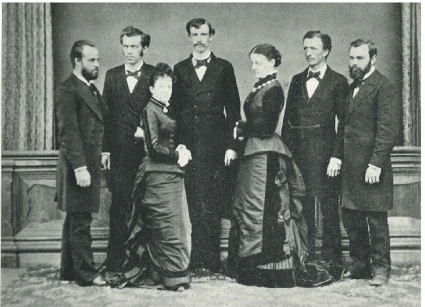President’s Column #2 – An enigmatic photo from 1879
President's Column | July 12, 2023
An enigmatic photo from 1879
“You all look too serious! Now, smile!”
One of the important tasks of a university president is to take photos with many visitors. After nearly three years in this position, it is only natural to get good at making up a smile. I’ve got really good at making a smirk by turning the corners of my mouth upward and showing a little bit of teeth. The undignified habit of smiling reflexively has developed when the camera is pointed at me with the order of “Say, cheese!”
All over the world, people are now taking photos with their mobile phones and uploading countless photos to Instagram and Twitter. The world is inundated with “Say, cheese” photos. Needless to say, however, photography has a short history in Japan, and some of the first photographs taken in Japan are believed to date back to the 1850s when Commodore Matthew C. Perry of the US Navy forced Japan to open up to the outside world with his Black Ships. Photographs from that time are extremely valuable.
Hokkaido University has many old and valuable photographs, one of which is a photograph of the first American teachers and their wives at the Sapporo Agricultural College (the photo below). The photograph is said to have been taken at a photo studio in Sapporo in 1879.

The photo of the American teachers and their wives in 1879. From far right: Cecil Hobart Peabody, William Penn Brooks, the wife of William Wheeler, David Pearce Penhallow, the wife of David Pearce Penhallow, William Wheeler, and John Clarence Cutter. (Photo by Seiichi TAKEBAYASHI).
The picture is, from our current point of view, a strange one indeed. The first oddity we notice is that the teachers and their wives are each looking in different directions. If we look closely, we soon realize that none of them are looking towards the camera (even Dr. Penhallow, who is in the center facing the camera, is gazing obliquely to the viewer’s left). In the commemorative photographs we are used to, it is natural that everyone is looking at the camera. But in the 1879 photograph, American teachers and their wives all look in different directions. And secondly, they all have serious expressions on their faces, and none of them are smiling. It is indeed an enigmatic picture.
But, come to think of it, I have never seen a commemorative photograph of the great men of the past, or of their predecessors, with a fake smile on their faces. This may be partly due to Japanese culture, which does not necessarily regard laughter as an outstanding form of civility in public situations. However, when we look at the fact that the American teachers at the Sapporo Agricultural College in the 1879 photo were not smiling in the slightest, it seems that the culture of smiling photographs has only taken root in the West in the modern era. Furthermore, the camera gaze, staring into the camera, may have been considered less than elegant. Thinking about it, this photo is not an enigmatic photo, but must most likely be a typical photograph conveying the social mores of gentlemen and ladies of that time.
I am a neurosurgeon and a specialist in neuroscience, and an expert on the nerves that create facial expressions and their mechanisms. Facial expressions are controlled by the facial nerve, which is almost the thickest bundle of nerves in the human body. The reason why such thick nerves were prepared for the control of only the smallest facial muscles must be because facial expression is extremely important for humans to demonstrate intentions.
Unlike this photograph of teachers from the USA during the Meiji era, the standard expression for a photograph, across the world, is now undoubtedly ‘the smile.’ However, the serious facial expressions of the pioneers at the Sapporo Agricultural College in 1879 without any smile apparently showed their strong determination to achieve their mission.
In fact, I don’t like photos of myself very much; in particular, I don’t like photos of me smiling. A serious expression is more dignified. A natural facial expression might be best in a photograph too: wouldn’t it be cool to have a photo like that of the American teachers and their wives at Sapporo Agricultural College in 1879?
Return to President’s Column Index
